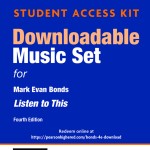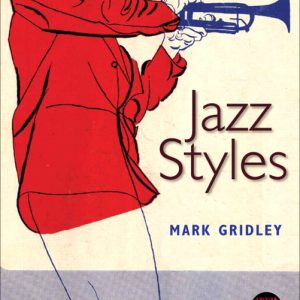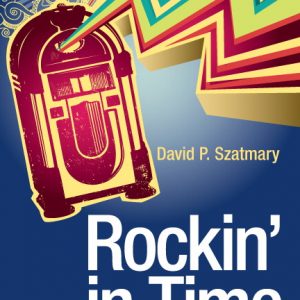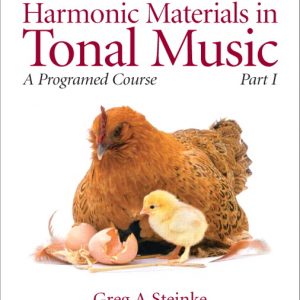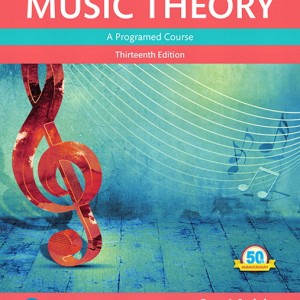Sony Music Card for Listen to This
$59.99
| Title | Range | Discount |
|---|---|---|
| Trade Discount | 5 + | 25% |
- Description
- Additional information
Description
This ISBN is for a digital download of the musical recordings to accompany Listen to This, Fourth Edition. This collection of music, chosen by author Mark Evan Bonds, includes 90 tracks, for 6–1/2 hours of music. Purchase this access code card in order to download the recordings package in Mp3 format from Sony Music.The Elements of Music: A Brief Introduction
PART I: THE MIDDLE AGES
1. Hildegard von Bingen, Play of Virtues (excerpt)
2. San Ildefonso Indians of New Mexico, Eagle Dance
3. Plainchant Alleluia, “Caro mea”
4. Francesco Landini, “Behold, Spring”
5. Guillaume de Machaut, “No More than One Man Could Count the Stars”
6. Alfonso el Sabio, Songs to the Virgin Mary, no. 147, “The Talking Sheep”
PART II: THE RENAISSANCE
7. Josquin des Prez, “The Cricket”
8. Thomas Weelkes, “Since Robin Hood”
9. William Byrd, “Sing Joyfully”
10. Giovanni Pierluigi da Palestrina, Pope Marcellus Mass, “Gloria”
11. Rhyming Singers of the Bahamas, “My Lord Help Me to Pray”
12. Tielman Susato, Moorish Dance
PART III: THE BAROQUE ERA
13. Claudio Monteverdi, Orpheus, selection from Act II
14. Henry Purcell, Dido and Aeneas, selections
15. Mbuti Pygmies, “Marriage Celebration Song”
16. Barbara Strozzi, “Revenge”
17. Antonio Vivaldi, The Four Seasons, “Winter,” first movement
18. Johann Sebastian Bach, Fugue in G Minor, BWV 578 (“Little” Fugue)
19. Johann Sebastian Bach, Brandenburg Concerto no. 2 in F Major, BWV 1047, finale
20. Johann Sebastian Bach, Cantata 140: Awake, a Voice Calls to Us, selections
21. George Frideric Handel, Messiah, selections
PART IV: THE CLASSICAL ERA
22. Joseph Haydn, String Quartet in C Major, op. 76, no. 3, second movement
23. Master Musicians of the Ikuta-ryu, Cherry Blossom
24. Joseph Haydn, Symphony no. 102 in B-flat Major, third and fourth movements
25. Wolfgang Amadeus Mozart, Symphony no. 40 in G Minor, K. 550, first movement
26. Wolfgang Amadeus Mozart, Piano Concerto in A Major, K. 488, first movement
27. Wolfgang Amadeus Mozart, The Marriage of Figaro, Act I, “Cosa sento”
28. Jingju, “The Reunion”
29. William Billings, “Chester”
PART V: THE NINETEENTH CENTURY
30. Ludwig van Beethoven, Symphony no. 5 in C Minor, op. 67
31. Franz Schubert, “Erlkönig,” D. 328
32. Felix Mendelssohn, Overture to A Midsummer Night’s Dream
33. Hector Berlioz, Symphonie fantastique, fourth movement (“March to the Scaffold”)
34. Fanny Mendelssohn Hensel, Piano Trio in D Minor, op. 11, third movement (“Song”)
35. Robert Schumann, “Dedication”
36. Clara Wieck Schumann, “Forward!”
37. Frédéric Chopin, Mazurka in B-flat Major, op. 7, no. 1
38. Louis Moreau Gottschalk, Union: Concert Paraphrase on National Airs
39. Ravi Shankar, Raga Sindhi-Bhairavi
40. Giuseppe Verdi, La Traviata, Act I, selection (“Follie!”)
41. Richard Wagner, The Valkyrie, Act III, selection (“Wotan’s Farewell”)
42. Peter Ilyich Tchaikovsky, Swan Lake, Act IV, finale
43. Johannes Brahms, Symphony no. 4 in E Minor, op. 98, finale
44. Antonín DvoYák, String Quartet in F Major, op. 96 (“American”), third movement
PART VI: SINCE 1900
45. Claude Debussy, Voiles
46. Charles Ives, The Unanswered Question
47. Arnold Schoenberg, “Columbine” from Pierrot lunaire
48. Igor Stravinsky, The Rite of Spring, Part One
49. Scott Joplin, Maple Leaf Rag
50. Robert Johnson, “Terraplane Blues”
51. Duke Ellington, “Cotton Tail”
52. Charlie Parker, “Ornithology”
53. Ruth Crawford, Piano Study in Mixed Accents
54. Germaine Tailleferre, Concertino for Harp and Orchestra, finale
55. William Grant Still, “A Black Pierrot” from Songs of Separation
56. Aaron Copland, “Hoe-Down” from Rodeo
57. Béla Bartók, Concerto for Orchestra, second movement (“Game of Pairs”)
58. Leonard Bernstein, “Tonight” from West Side Story
59. John Cage, Sonata II from Sonatas and Interludes
60. Gamelan Gong Kebyar of Belaluan, Bali, Kebyar Ding III, “Oncang-oncangan”
61. Philip Glass, “Knee Play 1” from Einstein on the Beach
62. Mahalia Jackson, “It Don’t Cost Very Much”
63. Tania León, A la Par, second movement (“Guaguancó”)
64. Corey Dargel, “On This Date Every Year”
65. Austin Wintory, “Nascence,” from Journey
Revel Bonus Chapters
66. Chuck Berry, “School Day”
67. The Sex Pistols, “God Save the Queen”
68. Public Enemy, “Fight the Power”
69. John Williams, “The Walls Converge,” from Star Wars
This ISBN is for a digital download of the musical recordings to accompany Listen to This, Fourth Edition. This collection of music, chosen by author Mark Evan Bonds, includes 90 tracks, for 6–1/2 hours of music. Purchase this access code card in order to download the recordings package in Mp3 format from Sony Music.Dynamic content designed for the way today’s students read, think, and learn brings concepts to life
- Students can stream music at the click of a button within each chapter in two ways: in a simple audio player and in the Listening Guide player. The “audio only” version of the music is placed early in the chapter, where students listen to the music for the first time. The Listening Guide player is placed after students have learned the key vocabulary and concepts of the chapter.
- Integrated within the narrative, interactives and videos empower students to engage with concepts and take an active role in learning. Revel’s unique presentation of media as an intrinsic part of course content brings the hallmark features of Listen to This to life. Revel’s media interactives have been designed to be completed quickly, and its videos are brief, so students stay focused and on task.
- Instruments of the Orchestra videos, created exclusively for Pearson, complement the expanded coverage of timbre in the book Introduction, “The Elements of Music: A Brief Introduction.”
- Animated notations and graphical scores help take some of the mystery out of musical notation and let students “see” the music as it unfolds through time. These animations were developed by the composer and educator Stephen Malinowski.
- Auto-graded listening quizzes and concept review quizzes in every chapter offer students the chance to apply and test their understanding of chapter content.
- The Revel mobile app lets students read, listen, practice, and study — anywhere, anytime, on any device. Content is available both online and offline, and the app syncs work across all registered devices automatically, giving students great flexibility to toggle between phone, tablet, and laptop as they move through their day. The app also lets students set assignment notifications to stay on top of all due dates.
- Revel’s writing functionality enables educators to integrate writing — among the best ways to foster and assess critical thinking — into the course without significantly impacting their grading burden. Self-paced Journaling Prompts throughout the narrative encourage students to express their thoughts without breaking stride in their reading. Assignable Shared Writing Activities direct students to share written responses with classmates, fostering peer discussion. Essays integrated directly within Revel allow instructors to assign the precise writing tasks they need for the course.
- Highlighting, note taking, and a glossary let students read and study however they like. Educators can add notes for students, too, including reminders or study tips.
Listening Guides describe what is happening within the key elements of the piece, as the music is playing
Within each Listening Guide, there are multiple options for guided listening, so that students can pick the options that best fit their learning style and listening environment.
- Interactive Listening Guides display descriptions as the music is playing. Each key element in a piece is represented by a distinctly colored line, allowing students to track changes in melody, harmony, rhythm, texture, timbre, and/or dynamics as well as form. Students can move around in the piece using these lines, and then can hide lines if they want a tighter focus.
- For readers who prefer a guide that scrolls from top to bottom, the vertical Scrolling Listening Guide is available.
- Narrated Listening Guides, written and spoken by author Mark Evan Bonds, combine music audio with a voiceover description of what to listen for. These narrated guides are ideal for auditory learners, students studying on a mobile device, or even for use in the classroom.
- Listening quizzes following the Listening Guides give students opportunities to check their understanding.
A unique instructional design and engaging features boost student interest and understanding
- Listen to This encourages students to listen actively by demonstrating how individual works are built on different combinations of a few basic elements. In the book’s Introduction, author Mark Evan Bonds defines the elements common to all types of musical expression around the world — melody, dynamics, rhythm, harmony, texture, timbre, form, and word-music relationships.
- Then, using a unique modular organization, Bonds presents one work per chapter, consistently taking students from a first listen, through a discussion of how the musical elements operate in the piece, to a deeper experience of the music in a Listening Guide. Feature boxes present fascinating details about the composer’s life and times as well as performance practices.
- The Connect Your Playlist feature encourages students to connect the music from the course to music that they already know and love. Each Connect Your Playlist takes a chapter concept and gives an example of this concept from contemporary popular music. Students are prompted to find an example of their own and explain their choice by way of a Shared Writing Assignment.
- The Expand Your Playlist feature helps students broaden their knowledge of the composer and style period through an annotated list of music for further listening.
- World music examples are included throughout the book. These global connection chapters suggest how concepts such as monophonic texture, polyphony, ostinato, and virtuosity can be found in music around the world and also help students better understand the full range of musical expression.
New and updated content ensures a comprehensive listening and learning experience
- NEW! The Fourth Edition includes coverage of several new and expanded topics including:
- Expanded coverage of timbre, including new text and videos on the instruments of the orchestra. A new Listening Guide for Britten’s The Young Person’s Guide to the Orchestra is also included as a capstone example in the first chapter, “The Elements of Music: A Brief Introduction”;
- A new chapter on Palestrina’s “Gloria” from the Pope Marcellus Mass as an example of Renaissance polyphony for the Catholic service;
- A new chapter on Tchaikovsky’s Swan Lake as an example of Russian Romanticism and ballet music;
- “Dido’s Lament” from Dido and Aeneas as an additional example of Purcell’s expressive use of ostinato bass; and
- New selections for Machaut and Alfonso el Sabio based on new recording options.
- EXPANDED! The Fourth Edition is accompanied by an expanded recordings package chosen by author Mark Evan Bonds, including 90 tracks for 6–1/2 hours of music. The music is available in three ways: streaming through Revel™, streaming through MyLab™ Music, and as an Mp3 download from Sony Music to the student’s music library. The Mp3 download from Sony Music is available from Pearson by purchase of an access code card.
Superior assignability and tracking tools help educators make sure students are completing their reading and understanding core concepts
- Revel’s assignment calendar allows educators to indicate precisely which readings must be completed on which dates. This clear, detailed schedule helps students stay on task by eliminating any ambiguity as to which material will be covered during each class. When they understand exactly what is expected of them, students are better motivated to keep up.
- Revel’s performance dashboard empowers educators to monitor class assignment completion as well as individual student achievement. Actionable information, such as points earned on quizzes and tests and time on task, helps educators intersect with their students in meaningful ways. For example, the trending column reveals whether students’ grades are improving or declining, helping educators to identify students who might need help to stay on track.
- Revel’s Blackboard Learn™ integration provides institutions, instructors, and students easy access to their Revel courses. With single sign-on, students can be ready to access Revel’s interactive blend of authors’ narrative, media, and assessment on their first day. Flexible, on-demand grade synchronization capabilities allow educators to control exactly which Revel grades should be transferred to the Blackboard Gradebook.
- Students can stream music at the click of a button within each chapter in two ways: in a simple audio player and in the Listening Guide player. The “audio only” version of the music is placed early in the chapter, where students listen to the music for the first time. The Listening Guide player is placed after students have learned the key vocabulary and concepts of the chapter.
- Integrated within the narrative, interactives and videos empower students to engage with concepts and take an active role in learning. Revel’s unique presentation of media as an intrinsic part of course content brings the hallmark features of Listen to This to life. Revel’s media interactives have been designed to be completed quickly, and its videos are brief, so students stay focused and on task.
- Instruments of the Orchestra videos, created exclusively for Pearson, complement the expanded coverage of timbre in the book Introduction, “The Elements of Music: A Brief Introduction.”
- Animated notations and graphical scores help take some of the mystery out of musical notation and let students “see” the music as it unfolds through time. These animations were developed by the composer and educator Stephen Malinowski.
- Auto-graded listening quizzes and concept review quizzes in every chapter offer students the chance to apply and test their understanding of chapter content.
- The Revel mobile app lets students read, listen, practice, and study — anywhere, anytime, on any device. Content is available both online and offline, and the app syncs work across all registered devices automatically, giving students great flexibility to toggle between phone, tablet, and laptop as they move through their day. The app also lets students set assignment notifications to stay on top of all due dates.
- Revel’s writing functionality enables educators to integrate writing — among the best ways to foster and assess critical thinking — into the course without significantly impacting their grading burden. Self-paced Journaling Prompts throughout the narrative encourage students to express their thoughts without breaking stride in their reading. Assignable Shared Writing Activities direct students to share written responses with classmates, fostering peer discussion. Essays integrated directly within Revel allow instructors to assign the precise writing tasks they need for the course.
- Highlighting, note taking, and a glossary let students read and study however they like. Educators can add notes for students, too, including reminders or study tips.
Listening Guides describe what is happening within the key elements of the piece, as the music is playing
Within each Listening Guide, there are multiple options for guided listening, so that students can pick the options that best fit their learning style and listening environment.
- Interactive Listening Guides display descriptions as the music is playing. Each key element in a piece is represented by a distinctly colored line, allowing students to track changes in melody, harmony, rhythm, texture, timbre, and/or dynamics as well as form. Students can move around in the piece using these lines, and then can hide lines if they want a tighter focus.
- For readers who prefer a guide that scrolls from top to bottom, the vertical Scrolling Listening Guide is available.
- Narrated Listening Guides, written and spoken by author Mark Evan Bonds, combine music audio with a voiceover description of what to listen for. These narrated guides are ideal for auditory learners, students studying on a mobile device, or even for use in the classroom.
- Listening quizzes following the Listening Guides give students opportunities to check their understanding.
New and updated content ensures a comprehensive listening and learning experience
- The Fourth Edition includes coverage of several new and expanded topics including:
- Expanded coverage of timbre, including new text and videos on the instruments of the orchestra. A new Listening Guide for Britten’s The Young Person’s Guide to the Orchestra is also included as a capstone example in the first chapter, “The Elements of Music: A Brief Introduction”;
- A new chapter on Palestrina’s “Gloria” from the Pope Marcellus Mass as an example of Renaissance polyphony for the Catholic service;
- A new chapter on Tchaikovsky’s Swan Lake as an example of Russian Romanticism and ballet music;
- “Dido’s Lament” from Dido and Aeneas as an additional example of Purcell’s expressive use of ostinato bass; and
- New selections for Machaut and Alfonso el Sabio based on new recording options.
- EXPANDED! The Fourth Edition is accompanied by an expanded recordings package chosen by author Mark Evan Bonds, including 90 tracks for 6–1/2 hours of music. The music is available in three ways: streaming through Revel™, streaming through MyLab™ Music, and as an Mp3 download from Sony Music to the student’s music library. The Mp3 download from Sony Music is available from Pearson by purchase of an access code card.
Superior assignability and tracking tools help educators make sure students are completing their reading and understanding core concepts
- Revel’s assignment calendar allows educators to indicate precisely which readings must be completed on which dates. This clear, detailed schedule helps students stay on task by eliminating any ambiguity as to which material will be covered during each class. When they understand exactly what is expected of them, students are better motivated to keep up.
- Revel’s performance dashboard empowers educators to monitor class assignment completion as well as individual student achievement. Actionable information, such as points earned on quizzes and tests and time on task, helps educators intersect with their students in meaningful ways. For example, the trending column reveals whether students’ grades are improving or declining, helping educators to identify students who might need help to stay on track.
- Revel’s Blackboard Learn™ integration provides institutions, instructors, and students easy access to their Revel courses. With single sign-on, students can be ready to access Revel’s interactive blend of authors’ narrative, media, and assessment on their first day. Flexible, on-demand grade synchronization capabilities allow educators to control exactly which Revel grades should be transferred to the Blackboard Gradebook.
Mark Evan Bonds is the Cary C. Boshamer Distinguished Professor of Music at the University of North Carolina at Chapel Hill, where he has taught since 1992. He holds degrees from Duke University (B.A.), Christian-Albrechts-Universität Kiel (M.A.) and Harvard University (Ph.D.). His books include Wordless Rhetoric: Musical Form and the Metaphor of the Oration (1991), After Beethoven: Imperatives of Symphonic Originality (1996), Music as Thought: Listening to the Symphony in the Age of Beethoven (2006), and Absolute Music: The History of an Idea (2014). He is the author of numerous essays on the music of Haydn and Mozart, on the nineteenth-century symphony, and on the aesthetics and philosophy of music. He has received grants from the National Endowment for the Humanities, the American Council of Learned Societies, and the William N. Reynolds Foundation. The fourth edition of his History of Music in Western Culture, a textbook for undergraduate music history survey courses, was published by Pearson in 2013. The new fourth edition of Listen to This reflects his experience and dedication to teaching music appreciation to undergraduates for more than 20 years.
Additional information
| Dimensions | 0.06 × 8.50 × 11.00 in |
|---|---|
| Imprint | |
| Format | |
| ISBN-13 | |
| ISBN-10 | |
| Author | |
| Subjects | music, higher education, humanities, music appreciation, Humanities and Social Sciences |


